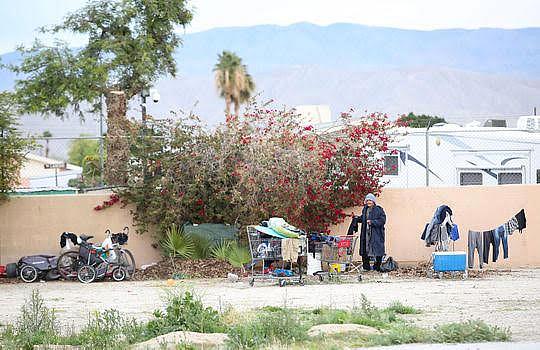You asked, we answered: Who is homeless in the Coachella Valley?
This story was produced as part of a larger project led by Nicole Hayden, a participant in the USC Center for Health Journalism's 2019 Data Fellowship.
Other stories in this series include:
The Desert Sun interviewed 200 homeless individuals about health care. Here's what we found
You asked, we answered: How can people help those who are homeless in the Coachella Valley?
You asked, we answered: How is money being spent on homeless services in Riverside County?
Homeless in the Coachella Valley: Join us for a special evening of storytelling, solutions
You asked, we answered: Why did Roy’s Resource center close in Palm Springs?

(Photo: Jay Calderon/The Desert Sun)
My name is Nicole Hayden and I’m The Desert Sun’s health reporter. Since I began at the paper, my interest in homelessness in the Coachella Valley has grown. I usually write articles when something happens — cities declare a shelter crisis, a camp is broken up or local partners declare new goals to address homelessness. But I always wonder if I am helping Coachella Valley residents understand the context that sits below the surface of these events.
That’s why in December I asked Desert Sun readers for your burning questions about homelessness. Nearly 70 of you responded — thank you for that. Over the next few months, I’ll publish regular answers to your questions. You can sign up to get updates on the project by emailing me at Nicole.Hayden@desertsun.com.
This is the first installment of the Q&A series.
Question: Who is experiencing homelessness in the Coachella Valley?
Many of you had a simple question: Who is homeless in the Coachella Valley and are those seeking services in the valley from here?
Eli Rector of Palm Desert submitted one of the questions, wanting to know how many people with mental illness end up on the streets. Rector is a behavior analyst in Palm Desert who works with children with disabilities.
“Sometimes in my work I come across situations where people become homeless because they don’t have the skills to transition to adulthood and they don’t have parents who are able to help,” Rector said. “So, I am sensitive to people who are struggling in society.”
Paul Zapala, a real estate broker in Palm Springs, submitted similar questions. Zapala said he has seen unsheltered homelessness increase in downtown Palm Springs during the past few years — something he can see out of his office window every day. Zapala wanted to know if those who are homeless are local residents or if they are traveling in from elsewhere.
“We are a small town and my concern is that there is a huge fluctuation,” Zapala said. “How do we make sure we are taking care of our own and are not just a magnet for others to come here for the services we have?”
Answer: Families, women, men, seniors who were born and raised in the desert
While the overall number of homeless people decreased in from 2017 to 2018, the number of unsheltered homeless people in the desert has increased. In 2017, 1,638 people in Riverside County had no shelter during a single day in January and in 2018, that number hit 1,685, according to the 2018 homeless point-in-time count. In the Coachella Valley, that unsheltered number hit 438.
Unsheltered homeless is when people live outdoors, compared with sheltered homelessness, when people live in emergency shelter or transitional housing.
Geography: The 2018 point-in-time count shows that most people experiencing homelessness in the Coachella Valley were found in Palm Springs. However, data from the county shows that most people who accessed emergency shelter services in the valley reported Indio was their last permanent home.
Of 4,407 unduplicated people seeking emergency shelter in Riverside County in 2017, 17 percent of those individuals were from Indio, 9 percent from the city of Riverside, 7 percent from Palm Springs, 5 percent from Desert Hot Springs and 3 percent from Coachella. The rest were mostly from other cities within the county and only a few were from the Los Angeles area or from other states.
While the point-in-time count shows only a snippet of a single day, the Riverside County data represents homelessness for the whole year.
Race: In the Coachella Valley, 76 percent of those experiencing unsheltered homelessness were white, 9 percent black, 6 percent were Native American, 4 percent were Asian and 3 percent were Hawaiian or Pacific Islander.
Ethnicity: In the Coachella Valley, 41 percent of people experiencing unsheltered homelessness were Hispanic or Latino.
Families: Of those seeking emergency shelter in the valley, 16 percent are families with children. Of those living in transitional housing, 57 percent are families with children and 29 percent of those with a permanent supportive housing voucher are families with children.
Gender: Women make up 25 percent of the unsheltered homeless population in the Coachella Valley, men 73 percent.
Ages: The majority (51 percent) of those who are unsheltered in the valley are 25 to 49 years old and 27 percent are 50 to 61.
Subpopulations: Of the total unsheltered population of 437 people, according to the 2018 point-in-time county, 5 percent are veterans, 18 percent struggle with alcohol addiction, 39 percent struggle with drug use, 23 percent have post-traumatic stress disorder and 17 percent have been diagnosed with mental health conditions, though local officials say many more go undiagnosed.
Desert Sun reporter Nicole Hayden covers health and healthcare in the Coachella Valley. She can be reached at Nicole.Hayden@desertsun.com or (760) 778-4623. Follow her on Twitter @Nicole_A_Hayden.
[This story was originally published by Desert Sun.]

